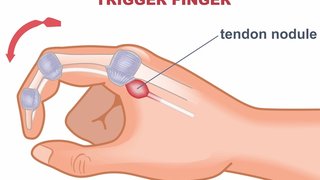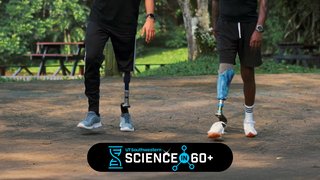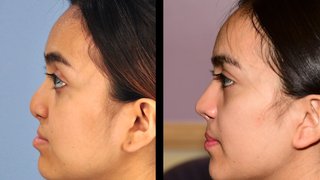Restoring hand function impaired by Dupuytren’s contracture
March 16, 2022

We take our hands for granted. That is, until health conditions interfere and we can’t use them properly. Former NFL quarterback John Elway struggled with Dupuytren’s contracture – a hand-deforming condition – for 15 years before getting the right treatment.
Dupuytren’s contracture causes the fibrous layer of tissue in the palm and fingers to thicken and tighten. Over time, a cord of tissue can develop, pulling one or more fingers – most often the pinky and ring fingers – toward the palm in an awkward, bent position.
Though Dupuytren’s contracture usually isn’t painful, for the approximately 7% of U.S. adults who have it the condition can affect their ability to do everyday activities such as holding a coffee cup or putting your hand in your pocket.
In Elway’s case, he could no longer hold a football the right way. His deformity was cured through non-invasive treatment, and many options are available that can fully restore mobility. Early treatment provides the best outcomes. In severe cases, microsurgery performed by a specialized hand surgeon can restore mobility and flexibility without disturbing the delicate nerves and tendons in the hand.
At UT Southwestern, we help restore mobility and dexterity for patients with new or returning symptoms, as well as people who haven’t had full range of motion or straightened their fingers for more than a decade. Particularly in those cases, it’s amazing to help patients return to doing the things they need and love.
Causes and symptoms of Dupuytren’s contracture
The exact cause of Dupuytren’s contracture isn’t known, but it is believed to run in families. Prevalent in people of Northern European descent, it’s sometimes referred to as Viking disease and can be traced back centuries to 865. There are also records of it affecting bagpipers in Scotland in the 15th century. You may be at greater risk for the condition if you:
- Are 40 or older and male
- Have a Northern European ancestry
- Smoke or consume alcohol
- Have diabetes
- Take seizure medication
- Had a previous hand injury
Dupuytren’s contracture develops slowly over years. Symptoms usually start as thickening of the skin on the palm of the hand, almost like a callous. As the condition progresses, symptoms can include:
- One or more lumps of tissue on the palm
- Thick bands of tissue in the palm that pull the fingers forward and/or down
- Pits or grooves in the skin compressed by the bent finger
- Not being able to flatten your hand on a table
In rare cases, Dupuytren’s contracture can affect the feet or penis.
Because Dupuytren’s contracture progresses slowly, it may not require treatment for several years. However, if it begins to reduce your quality of life, talk with a doctor about your options. Early treatment can keep the condition from becoming worse and keep the finger joints from becoming stiff and arthritic.
Related reading callout: 6 plastic surgery options for treating rheumatoid arthritis
A close-up view of fasciectomy to fix Dupuytren's contracture
Treatments for Dupuytren’s contracture
Patients with mild to moderate Dupuytren’s contracture rarely need surgery. Non-invasive procedures can relieve symptoms by removing or severing deformed tissue in the hand. Surgery may be the best choice for patients with severe symptoms, nerves close to or intertwined with the cord, or cords that return after previous treatment.
Needle aponeurotomy
In this minimally invasive procedure, we will numb the area and insert a needle into the skin. Using the needle like a small knife, the hand surgeon will sever the cord pulling your finger down. You will be able to use your hand normally after the procedure, and you will need to wear a splint at night for two months.
Enzyme injection
A hand surgeon will inject an enzyme (protein) that breaks down and dissolves the cord. A day or two later, we will manipulate the remaining cord tissue to break it apart and straighten your finger. You will be able to use your hand normally after the procedure, and you will need to wear a splint at night for two months.
Fasciectomy
This is a surgery to fully remove the cord. You will be put under general anesthesia, and a hand surgeon will make a zig-zag incision in your palm to move the skin out of the way. Then we’ll cut each end of the cord and remove the thickened tissue. This is an outpatient surgery, so you’ll go home the same day. You’ll wear a plaster splint for two weeks and attend physical therapy for a few months to regain hand dexterity and mobility.
See a hand specialist for Dupuytren’s contracture
Dupuytren’s contracture does not affect the tendons in the hand. However, tendons and nerves often are situated next to or sometimes wrapped around the thickened tissue pulling your finger down.
This is why it’s important to seek treatment from a hand surgeon. Our Plastic Surgery hand specialists have unique expertise in the structures of the hand and have the expertise to effectively relieve Dupuytren’s contracture while reducing the risk of nerve or tendon damage.
We are always seeking the best way to help our patients regain full function of their hand. This includes conducting and participating in clinical studies.
For seven years, I have been conducting a study with patients at the Dallas VA Medical Center. Our goal is to determine whether enzyme injections or fasciectomy (surgery) are the best treatment to reduce recurrence in patients with moderate to severe Dupuytren’s contracture. Most importantly, we want to be able to better advise our patients on the potential benefits of each treatment.
Your hands play a crucial role in performing everyday activities. If Dupuytren’s contracture interferes with daily living, talk with a hand specialist. We are here to help.
To discuss Dupuytren’s contracture treatment, call 214-645-8300 or request an appointment online.











